Working to improve mutual understanding between the Middle East and the West
Working to improve mutual understanding between the Middle East and the West
No products in the basket.
Niloofar Kakhi’s Nationalism in the Architecture of Modern Iran charts the fascinating and contested history of the development of a national architectural identity in Iran across the 20th century and on into the creative turbulence of international architecture today. Beginning with a discussion of Iranian architecture in the late Kajar period, up to 1925, and its successor, the Pahlavi dynasty (1925-79), Kakhi describes the establishment of the Iranian Society of National Heritage, and the first steps toward the foundation of an academic discipline in the western Beaux Arts tradition, under such international figures as André Godard, Ernst Herzfeld, and Arthur Pope. The narrative goes on to consider the importance of archaeological discoveries, particularly of the Archaemenid (c.705 – 329BCE) and Sassanian (224-651CE) periods, on Iranian architecture, and the tension this set up between concepts of national identity and the influence of international modernism. These are explored through detailed discussion of such significant sites as Tehran’s National Garden, the Parade Ground and the Ferdowsi Monument, of such authorities as Mohsen Foroughi and Houshang Seyhoun; and of the paralells between architecture in Iran and in the broader Middle East.
The re-invention and importance of such architectural features as the iwan and the chahar-taq are explained for the reader, as is the role played by specific core texts, Sufi mysticism, and the first international congresses, constructing a conceptual platform for critically assessing representations of national identity in contemporary Iranian architecture, and enabling the development a comprehensive understanding of the modern history of architecture in Iran.
Niloofar Kakhi is an architect and researcher. She received her PhD in Histories and Theories of Architecture from Architectural Association. She has recently finished a Visiting Research Fellowship at the University of St Andrews.
| Weight | 1 kg |
|---|
Acknowledgements vii
Introduction 1
Architectural Challenges in Modern Iran 2
Nationalism and its Architectural Representation 9
Conflictual Modernisation 14
1. Architecture, the Rise of Nationalism and the Early Reforms 19
Qajar Tehran 19
The Development of Nationalism in Iran 33
Saramadan-e Honar: A Blueprint for National Architecture 37
From the Parade Ground to the National Garden (1925–34) 41
2. Politics and the Production of Architectural Knowledge 51
The Past as Heritage: The Society for National Heritage
(Anjoman-e Asar-e Melli) 51
An Awakening Lecture 58
Ferdowsi’s Mausoleum: The Construction of a National Project 66
Development of History and Archaeology: Towards the Formation of a ‘Representative’ Architecture 80
From the National Garden to Tehran’s Capitol Complex (1934–41) 92
3. Developments in Architectural Discipline (1941–79) 101
Founding the New Educational System 101
The University of Tehran 109
The Establishment of the Faculty of Fine Arts under André Godard (1940–53) 112
Nationalism in Architecture of Modern Iran.indd 5 22/10/2024 12:34
The Modern: The Faculty of Fine Arts under Mohsen Foroughi (1953–62) 119
The Vernacular: The Faculty of Fine Arts under Houshang Seyhoun (1962–8) 127
The Authentic: The Faculty of Fine Arts under Mohammad Amin Mirfendereski (1968–79) 133
The Development of Architectural Histories and Theories 138
Persian Architecture at a Glance: Mohammad Taqi Mostafavi (1967–71) 139
‘The Stylistics of Architecture in Iran’: Mohammad Karim Pirnia (1968) 145
The Sense of Unity: Nader Ardalan and Laleh Bakhtiar (1973) 149
The International Approach to a Nationalist Question: The Architectural Congresses of 1970 and 1974 155
Shahyad Aryamehr: The End of a Tradition (1971) 169
Projects of Authenticity 176
4. Revolution and Continuity 185
The Post-Revolution Academic Reforms 185
Re-programming the Capitol Complexes: The Urban Expressions of Change 191
Addressing the Question of Identity 205
5. Conclusion: The Value of the Present 227
Bibliography 245
Picture Credits 253
Introduction
This book provides an historical framework against which to examine the key architectural challenge in modern Iran – that is, how to design a building that represents Iranian identity and ultimately, how to strike a balance between Iran’s rich pre-modern architectural heritage and the requirements of a modernised society. To this end, I approach the question of the architectural representation of Iranian identity within the context of nationalism and under the influence of the politics of nationalism since the early twentieth century in Iran – two factors that have made Iranian architecture greatly dependent on the revival of historic forms. By giving an historical survey of this discourse, this book shows how, despite many disciplinary and political changes, the architectural representation of national identity in Iran has maintained its intrinsic historicism, and hence its ‘conflictual’ relationship with modernity in the present day. It constructs an historical platform for further critical assessments of this architectural representation, and revisits the neglected importance of the present as a means to express a collective and more inclusive approach to national identity in contemporary architecture.
The rise of nationalism, with its strong dependence on history and archaism on the one hand, and the escalation of the desire for modernisation on the other, overlapped in early twentieth-century Iran. This caused dichotomies and conflicting approaches to architectural design, stemming from these differing attitudes towards the past and the notion of heritage. Nationalist architecture, deeply influenced by the past and the increasing archaeological interest in ancient Persia, displayed an excessive use of visual references to the historic architecture of Iran, while early modernist architecture looked beyond political and cultural boundaries and sought to dissolve these historical ties with traditional architecture. The divergence between these two approaches, and their increasing distance from the principles of traditional and vernacular architecture, has polarised the discipline, and necessitated the pursuit of balance. Since the establishment of the Faculty of Fine Arts at the University of Tehran in the 1940s, and the increase in international connections within the discipline of architecture, many academics and architects have addressed this issue, and each has increased the many-layered nuances in its definition. This makes it even more important to pinpoint the initial question of the representation of the Iranian identity. With such concerns at the core of this book, various aspects of architectural knowledge and historiography, of cross-fertilisation and the influence of international architectural discourses, of the development of architectural education and of the design of key architectural projects are discussed in its four chapters. I argue that the architectural characteristics of nationalist architecture in early twentieth-century Iran, and its conflicting relationship with the forces of modernisation and modernist architecture, have greatly influenced the future of the practice in terms of the representation of national identity. I also argue that this is the result of the fusion of several forces: first, the rise of political interest in the past; second, the expansion of historical knowledge, particularly in the field of archaeology, which has profoundly influenced architectural histories; third, the appropriation of an architectural language, namely Beaux-Arts architecture, that has enabled the direct transmission of archaeological knowledge into the field of design; and finally, an education system that has facilitated the continuation, development and resilience of this approach, beyond sociopolitical upheavals, into the present day.
Architectural Challenges in Modern Iran In 1969, the government of Iran published a promotional report on recent extensive reforms in the country. In this, along with a celebration of Iran’s historical and cultural heritage, and the impressive developments underway especially in the urban and construction sectors, it uncritically acknowledged a division within the discipline of architecture. After condemning the ‘decline’ of the discipline under the Qajar dynasty (roughly 1789 to 1925), the report mentioned two distinct design approaches: one, glorifying the ancient past, was ‘to revive ancient Iranian styles’, while the other was ‘to adopt contemporary Western designs, and to combine them with the traditional’ in order to realise ‘the promise of a new life’. This division in architectural practice implied a strong sense of attachment to a distant and politically appealing past, while acknowledging the necessity of importing modern architectural advancements from the West to further the modernisation of Iran. What is also evident here is the emergence of a division between the immediate past and the actual conditions of the present, and an urge to create a balance between historical values and a forward-looking vision of modernisation.
The modern history of architecture in Iran is an arena in which the forces of modernity and an historicist understanding of authenticity and identity have challenged each other constantly. Architecture has had this pivotal question on its agenda for the last century: how to adapt to the effects of ever-necessary modernisation while maintaining a sense of cultural affinity and continuity in the built environment that represents Iranian identity. The rise of this architectural debate corresponds with the rise of nationalism in late Qajar- and early Pahlavi-period Iran. The modern basis of what is considered as authentic Iranian architecture is the representation of an official definition of national identity, the details of which have been framed and continuously modified since the establishment of the Pahlavi monarchy as the first modern Iranian nation-state in 1925.
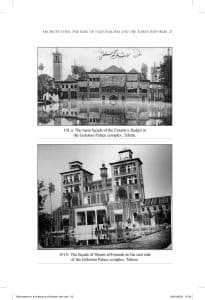
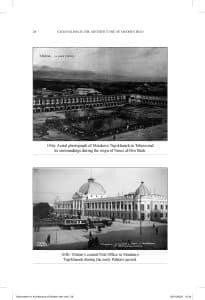
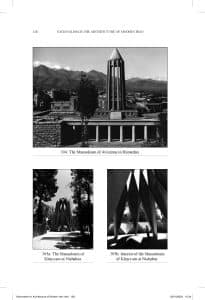
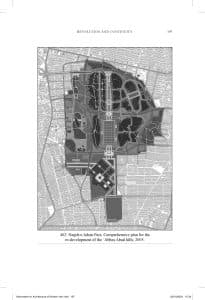
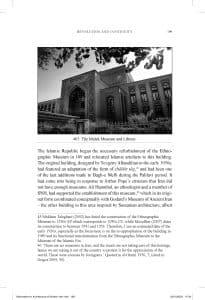
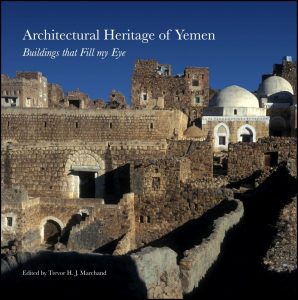
Niloofar Kakhi has produced a splendidly rich and engaging study on Iran’s experience of modernity in the twentieth century, viewed through the lens of architectural traditions. With clear vision and depth of knowledge, Kakhi navigates the myriad forces that shaped Iranian identity and architecture in this period.
Robert Steele, Postdoctoral Fellow at the Institute of Iranian Studies, Austrian Academy of Sciences
Niloofar Khaki’s study on the societal dimensions of architecture in contemporary Iran is a valuable contribution to the discourse on the representation of nationalism in twentieth century Iran.
Touraj Atabaki, Emeritus Professor of Social History of the Middle East and Central Asia at the Leiden University
Our work relies on the generous support of our donors. Any contribution, no matter how small, helps us achieve our aims.